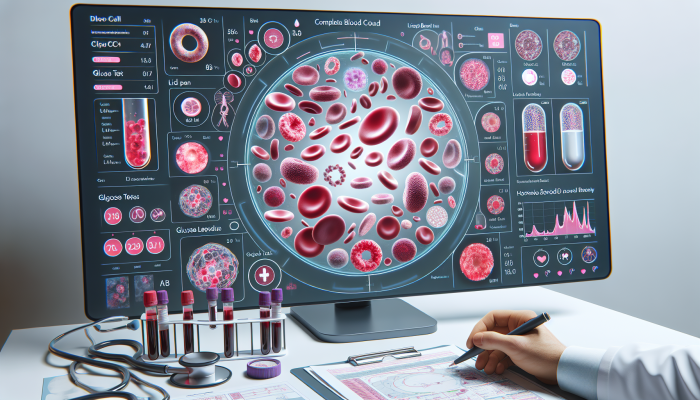Boost Your Confidence for a Positive Blood Test Experience
Discover the Varied Blood Tests and Their Vital Role in Your Health Journey

To enhance your confidence in blood tests, it is essential to understand the different types of blood tests and their unique functions. Blood tests are fundamental diagnostic tools used by healthcare providers to assess your overall health, track existing conditions, and guide treatment choices. Some common blood tests include the complete blood count (CBC), lipid panel, metabolic panel, and blood glucose tests. Each of these tests is specifically designed to measure particular health markers such as immune function, cholesterol levels, and more, providing crucial insights into your health status.
For example, a complete blood count delivers essential data about your red and white blood cells, hemoglobin, and platelets. This information can be valuable for diagnosing conditions such as anemia or various infections. In contrast, the lipid panel assesses your cholesterol levels and triglycerides, giving you a comprehensive view of your heart health. Additionally, the metabolic panel evaluates your body’s chemical balance and metabolic processes, revealing important details about your kidney and liver function. By gaining a clear understanding of each test’s purpose, you can eliminate confusion and take proactive steps to manage your health effectively.
Furthermore, understanding the reasons behind these tests can significantly alleviate anxiety. For instance, knowing that a fasting blood glucose test aims to evaluate your risk for diabetes can help you mentally prepare for the fasting requirement, while also highlighting its importance in safeguarding your health. This awareness fosters a sense of agency, ultimately increasing your blood test confidence.
Proven Techniques for Mental Preparation to Alleviate Anxiety
Mental preparedness is a key component in ensuring a calm and successful blood test experience. Implementing mindfulness strategies can ground you and help in reducing feelings of anxiety. Deep breathing exercises are particularly effective in calming your nerves prior to the test. Take a deep breath in through your nose for a count of four, hold it for four, and then gently exhale through your mouth for a count of six. By repeating this cycle several times, you can significantly lower your heart rate, easing feelings of anxiety and allowing you to approach your blood test with a sense of calm and composure.
Visualization is another powerful technique that can aid in your preparation. Picture yourself completing the blood test with ease and confidence. Visualize the phlebotomist’s reassuring demeanor and your own serene response to what is generally a quick and painless procedure. This mental imagery can shift your focus away from fear and towards empowerment, reminding you that you are taking an active role in your health journey and that you possess the strength to handle the situation effectively.
Additionally, consider reaching out to someone who has recently undergone a similar experience. Hearing about their positive outcomes can offer reassurance and help normalize your feelings. Engaging in light physical activities, such as taking short walks, can release endorphins that combat anxiety. By preparing mentally in advance, you create a supportive atmosphere for a successful and confident blood test experience.
In-Depth Overview of the Blood Draw Procedure to Ease Your Mind
Understanding the blood draw process can significantly reduce fear and apprehension related to the experience. Upon arrival for your blood test, you will typically begin by checking in at the front desk, where you may need to provide your insurance information and identification. Afterward, a phlebotomist will call you to a designated area that is often a private room or a curtained-off section designed to ensure your comfort during the procedure.
The process starts with the phlebotomist cleaning the area of your arm with an antiseptic wipe, a vital step for preventing infection. Following this, they will apply a tourniquet to make your veins more visible. You will likely be asked to clench and unclench your fist to engorge the veins, making it easier for the needle insertion. You may experience a brief pinch when the needle enters, but this sensation is fleeting, and the entire procedure usually concludes within just a few seconds. Most blood draws require only a few vials of blood, making the process quick and efficient.
Once your blood is drawn, the phlebotomist will place a bandage over the puncture site and may ask you to sit for a few minutes to ensure you don’t feel faint. They might also provide you with water or a light snack, especially if you had been fasting prior to the test. Familiarizing yourself with these steps can significantly enhance your blood test confidence. Rest assured, you are in capable hands, and knowing what to expect can help you maintain a sense of calm and composure throughout the procedure.
Overcoming Fear: Essential Strategies for Individuals with Needle Phobia

Identifying Needle Phobia: Recognizing Symptoms and Acceptance
For many individuals, the mere thought of a needle can evoke intense fear, a condition known as needle phobia. Recognizing the signs and symptoms of this phobia is the first step toward overcoming it. Common indicators include sweating, rapid heartbeat, feelings of nausea, or fainting at the mere thought of a needle or blood draw. If you find yourself avoiding necessary medical tests due to this fear, it is crucial to acknowledge it as a legitimate concern and realize that many others share similar experiences.
Needle phobia can arise from various factors, including past traumatic experiences, anxiety disorders, or heightened sensitivity in medical environments. Understanding that you are not alone in experiencing these feelings can help alleviate feelings of isolation. Recognizing your symptoms serves as a critical first step toward effectively addressing and managing your anxiety.
If your fear significantly impacts your ability to seek medical care, it may be time to explore coping strategies or seek professional assistance. Overcoming needle phobia is not simply about facing the fear; it’s about cultivating practical tools that empower you to confront it head-on. These blood test confidence strategies are designed to help you regain control over your health and well-being.
Distraction and Desensitization: Practical Strategies to Cope with Anxiety
Once you’ve identified your needle phobia, implementing effective coping strategies can significantly enhance your experience. Distraction techniques can be particularly helpful in this context. Consider bringing a friend or loved one to your appointment to help keep your mind engaged and occupied. Engaging in light conversation or focusing on a task—such as playing a game on your phone—can effectively divert your attention from the procedure, making the experience feel less intimidating.
Another valuable approach is desensitization. Gradually exposing yourself to elements associated with the blood test can help diminish your fear over time. Start by looking at images of needles, watching videos of blood draws, and practicing relaxation techniques while discussing your feelings about the procedure. This gradual exposure can significantly reduce your anxiety and help you feel more comfortable with the process. Remember, this journey is incremental, and every small step counts.
If your fear feels overwhelming, consider seeking professional help. Therapists specializing in cognitive-behavioral therapy (CBT) can provide you with tools to modify your thought patterns and responses to needles. Embracing these coping strategies is key to transforming fear into confidence and reclaiming your ability to manage your health effectively.
Recognizing When to Seek Professional Support: Understanding Your Needs

Sometimes, self-help strategies may not be adequate, and that is perfectly fine. If your needle phobia starts to impact your health or daily life, seeking professional support is a wise choice. A trained therapist can help you explore the underlying causes of your fear and develop personalized coping strategies tailored to your specific needs. Cognitive-behavioral therapy (CBT) has been shown to be effective in treating phobias by transforming negative thought patterns and behaviors.
Moreover, exposure therapy can be particularly beneficial for individuals suffering from needle phobia. This method involves gradually introducing you to the source of your fear—needles—under controlled and supportive conditions. Your therapist will guide you through the process, ensuring you feel safe and secure at every stage. This support can make a significant difference in your ability to cope with your phobia.
Don’t hesitate to share your fears with your healthcare provider as well. They may suggest options like using a smaller needle, applying numbing creams, or even offering sedation for particularly anxious patients. The goal is to create a supportive environment that respects your feelings while ensuring you receive the necessary medical care. With the right support, you can transform your blood test confidence from a place of fear to one of empowerment.
Nutrition and Hydration Tips to Enhance Your Blood Test Confidence
Understanding Fasting for Your Blood Test: Essential Guidelines
Fasting prior to a blood test can seem intimidating, but understanding the specific requirements can help ease your worries. Different blood tests have varying fasting guidelines. For example, a lipid panel usually requires a fast of 9 to 12 hours, while a glucose test may have similar requirements. Fasting is crucial for ensuring the accuracy of your results by eliminating the influence of recent food or drink intake, leading to more reliable insights into your health status.
It is essential to confirm with your healthcare provider which tests necessitate fasting. If you’re unsure, don’t hesitate to ask for clarification. Knowing exactly what to expect can significantly reduce your anxiety. If fasting is required, plan it for a time that allows you to manage your hunger comfortably—perhaps overnight. This strategy can contribute to a more relaxed experience when it comes time for your blood test.
During the fasting period, maintaining hydration is vital. Drinking water is typically permitted and encouraged, as it helps sustain blood volume and facilitates an easier blood draw. By adequately preparing for fasting, you can boost your blood test confidence and ensure the accuracy of your results.
Ensuring Adequate Hydration: Optimal Strategies for Staying Hydrated
Proper hydration is essential for a smooth blood draw. Being well-hydrated makes your veins more prominent, significantly easing the procedure and reducing the time it takes. However, it’s important to practice moderation; excessive water consumption can lead to overhydration, which might dilute certain blood components and potentially skew test results. Finding the right balance is crucial for a successful experience.
Aim to drink plenty of water in the hours leading up to your test—about 8 to 10 glasses is a reasonable goal. If your test requires fasting, continue to hydrate during this period. Avoid beverages containing sugars or caffeine, as these can negatively affect your results. Furthermore, steer clear of alcohol and excessive salt, as both can contribute to dehydration and complicate the blood draw process. Staying adequately hydrated not only facilitates a successful blood draw but also promotes your overall well-being.
Dietary Considerations Prior to Your Blood Test: Foods to Favor and Avoid
Your dietary choices leading up to your blood test can significantly influence the results, making it essential to know which foods to embrace and which to avoid. Generally, consuming a balanced and light meal before your test is advisable. Foods rich in fiber, such as fruits and vegetables, can help stabilize blood sugar levels, contributing to better overall health.
However, avoid high-fat and sugary foods, especially when preparing for a lipid panel. Such foods can elevate your triglycerides, leading to misleading results. If fasting is required, stick to clear liquids, avoiding anything containing caffeine or added sugars. Consulting your healthcare provider for tailored dietary recommendations based on the type of blood test you will undergo is also a wise strategy. They can guide you on which foods will best prepare your body for accurate results. By being mindful of your diet, you not only enhance your test results but also bolster your blood test confidence.
Understanding and Interpreting Blood Test Results: A Complete Guide
Interpreting Your Blood Test Report: Essential Metrics Explained
When you receive your blood test results, deciphering the metrics can initially seem daunting. However, familiarizing yourself with standard terms can empower you to take charge of your health. Key metrics often include hemoglobin levels, white blood cell counts, and cholesterol levels, each reflecting different aspects of your health and well-being.
For instance, hemoglobin levels indicate your blood’s capacity to transport oxygen; low levels may point to anemia, while elevated levels could suggest dehydration. White blood cell counts are crucial for evaluating your immune system—higher counts may signal infection or inflammation, while lower counts could indicate potential bone marrow issues. Understanding what these numbers signify can demystify your report and provide valuable insights into your overall health.
Moreover, lipid panels report total cholesterol, LDL (bad cholesterol), HDL (good cholesterol), and triglycerides. Familiarizing yourself with these terms can help you better understand your cardiovascular health. Don’t hesitate to consult your healthcare provider for assistance in interpreting your results, as this knowledge is fundamental to your blood test confidence and enables you to make informed health decisions.
Recognizing Normal vs. Abnormal Results: Key Indicators to Watch For
Understanding the difference between normal and abnormal results is crucial for effective health management. Each test has established reference ranges, typically defined by the analyzing laboratory. Familiarizing yourself with these ranges can help you determine whether your results fall within normal limits, giving you a clearer perspective on your health status.
While some fluctuations in results may be considered normal due to factors like stress, hydration levels, or even the time of day, consistently abnormal results should prompt further evaluation. For example, elevated blood sugar levels might indicate a heightened risk for diabetes, while abnormal cholesterol levels could suggest potential heart disease. If you receive abnormal results, there’s no need to panic; instead, reach out to your healthcare provider to discuss your concerns and gain clarity on the implications. This proactive approach fosters a stronger blood test confidence and empowers you to take charge of your health decisions.
Engaging in Open Dialogue with Your Healthcare Provider: Essential Questions to Ask
After receiving your blood test results, it’s vital to have an open and clear conversation with your healthcare provider. Prepare a list of questions to ensure you thoroughly understand the implications of your results. Inquire about what the results signify, their importance, and what subsequent steps you should take based on your findings.
Depending on your results, ask about any lifestyle changes you might need to implement. For instance, if your cholesterol levels are elevated, seek dietary recommendations or exercise routines that could improve your situation. Additionally, don’t hesitate to inquire about any additional testing that might be necessary or any potential treatments you should consider. Gaining insight into your results and their broader context can significantly enhance your blood test confidence. Remember, your healthcare provider is there to support you and guide you through any uncertainties you may encounter.
Personalized Blood Test Confidence Strategies: Tailored Tips for Various Age Groups
Guidelines for Parents: Making Blood Tests Easier for Children
Navigating blood tests for children can be challenging for both parents and kids. To ease their fears, preparation is essential. Explain the process in simple, relatable terms, emphasizing that the test is quick and will not hurt for long. Use positive language to frame the experience as a necessary step for their health, reinforcing that it is a routine part of healthcare.
Consider bringing a comforting item, such as a favorite toy or blanket, to the appointment. This can provide a sense of security and familiarity for your child, helping them feel more at ease. Additionally, distraction techniques can be highly effective—engage them with a story, a game, or even a simple conversation while waiting for the procedure. This distraction can make the experience feel less intimidating and assist them in coping better.
Discuss potential options with the healthcare provider if your child is particularly anxious. They may suggest numbing creams or alternative methods to minimize discomfort. Empowering your child with knowledge, comfort, and support can significantly enhance their blood test confidence and foster a healthier attitude towards medical visits.
Supporting Elderly Patients: Promoting Comfort and Accuracy During Blood Tests
Older adults may face specific challenges during blood tests, such as fragile veins and increased anxiety levels. To ensure comfort and accuracy, communicate with the healthcare provider about any unique concerns regarding the patient’s health status. They can make adjustments to the procedure to accommodate these needs, ensuring a more comfortable experience.
Encouraging your elderly loved one to stay hydrated before the test is vital, as it can improve vein visibility and ease the blood draw process. If necessary, consider accompanying them to the appointment for emotional support. Familiar faces can provide reassurance and comfort during potentially stressful situations, reducing anxiety.
Moreover, discussing the purpose of the test and what the results entail can empower elderly patients. Transparency fosters trust and can alleviate their feelings of anxiety. Addressing their specific needs can help enhance their blood test confidence and encourage a positive healthcare experience, allowing them to feel more in control of their health.
Expectant Mothers: Navigating Blood Tests During Pregnancy
Pregnancy often necessitates blood tests to monitor both maternal and fetal health. Understanding the importance of these tests can help expectant mothers approach them with greater assurance. Common tests include evaluations for blood type, anemia, infections, and gestational diabetes, all critical for ensuring a healthy pregnancy.
Prepare mentally by learning about the purpose of each test and what to expect during the process. Discuss any worries with your healthcare provider; they can clarify why these tests are essential for both the mother and baby, making the experience feel less daunting. Staying hydrated and maintaining a balanced diet leading up to the tests is also crucial for your overall well-being.
Consider bringing a partner or support person to appointments for additional comfort. Sharing the experience can alleviate anxiety and provide emotional support. By approaching blood tests during pregnancy with knowledge and support, expectant mothers can enhance their blood test confidence and prioritize both their health and the health of their baby.
Leveraging Technology to Elevate Your Blood Test Confidence
Evaluating At-Home Blood Testing Kits: Pros and Cons
The rise of at-home blood testing kits offers a convenient alternative for many individuals. These kits allow you to conduct tests in the comfort of your home, providing rapid and discreet results. However, understanding the advantages and disadvantages is crucial for making an informed decision about whether this method suits your needs.
On the positive side, at-home kits provide flexibility and privacy, which can be particularly beneficial for those with needle phobia, as they may feel more comfortable in a familiar setting. Many kits offer results through user-friendly apps, enabling you to track your health over time effortlessly. This convenience can empower you in your health journey.
Conversely, there are drawbacks to consider. At-home tests may not achieve the same level of accuracy as laboratory tests, and interpreting results without professional guidance can be challenging. Additionally, some tests may require follow-up laboratory work for confirmation, potentially leading to confusion. Weighing these pros and cons can help you determine whether at-home testing enhances your blood test confidence and aligns with your health needs.
Mobile Applications: Tools for Monitoring Your Health and Interpreting Results
Mobile applications have revolutionized the way we manage our healthcare, particularly regarding blood tests. Numerous apps allow users to track their results over time, set reminders for upcoming tests, and access educational resources that explain what their results mean. This can significantly enhance your overall experience and understanding.
An app can considerably boost your blood test confidence by providing clarity and organization. You can centralize your health information, making it easier to share with healthcare providers during appointments. Some applications even offer personalized insights based on your results, empowering you to make informed decisions regarding your health based on reliable data.
However, it is essential to choose reputable apps that prioritize data security and accuracy. Look for applications endorsed by medical professionals or health institutions to ensure you are using a trustworthy tool. By leveraging technology effectively, you can take charge of your health journey with renewed confidence and clarity.
Remote Consultations: Accessing Expert Guidance from the Comfort of Your Home
Telehealth has simplified the process of consulting healthcare professionals regarding your blood tests without the need for in-person visits. Virtual consultations provide a convenient platform to discuss your results, ask questions, and receive guidance from your provider, making healthcare more accessible than ever before.
During a virtual consultation, you can review your blood test results in real-time, allowing for immediate clarification and direction on the next steps. This enhances your understanding and confidence in managing your health. You can also discuss any symptoms or concerns, leading to a more comprehensive approach to your care.
Take advantage of this modern healthcare solution to amplify your blood test confidence. Not only does it offer convenience, but it also fosters a collaborative relationship with your healthcare provider, ensuring you feel supported throughout your health journey.
Your Questions Answered: Frequently Asked Questions
What can I do if I feel anxious about my blood test?
Practice deep breathing techniques, visualize a positive outcome, and consider bringing a supportive person to your appointment to help manage anxiety and provide comfort throughout the process.
How should I prepare my child for a blood test?
Explain the process in simple terms, bring a comforting item, and utilize distraction techniques such as engaging stories or games to alleviate their nerves and make the experience more enjoyable.
What standard blood tests are performed during pregnancy?
Standard tests typically include assessments for blood type, anemia, infections, and gestational diabetes, which are crucial for monitoring maternal and fetal health throughout the pregnancy.
Can I eat before my blood test?
This varies based on the specific test requirements. Some tests necessitate fasting, while others do not. Always confirm with your healthcare provider for specific instructions regarding your preparation.
How can I interpret my blood test results?
Familiarize yourself with standard metrics and reference ranges, and consult your healthcare provider for clarity and guidance on your specific results to ensure you fully understand their implications.
What if I suffer from needle phobia?
Identify coping strategies, such as distraction techniques, gradual exposure, or seeking professional help, to manage your fear effectively and regain control over your health journey.
Are at-home blood testing kits reliable?
While they provide convenience, at-home kits may not match the accuracy of laboratory tests. It’s essential to follow up with your healthcare provider for confirmation and further guidance.
What questions should I ask my doctor regarding my blood test results?
Inquire about the implications of your results, any lifestyle changes you may need to adopt, and whether further testing is warranted based on your findings to ensure a comprehensive understanding of your health.
How does staying hydrated impact my blood test?
Proper hydration can make veins more visible, facilitating a smoother blood draw and enhancing comfort and accuracy during the procedure, ultimately contributing to a better overall experience.
What role do mobile apps play in managing blood test results?
Mobile apps can assist in tracking results, providing educational insights, and reminding you of upcoming tests, significantly enhancing your overall blood test confidence and promoting proactive health management.
This Article Was First Found On https://bloodtest.co.uk
The Article: Blood Test Confidence: Empower Your Health with These Tips appeared first on: https://ezbloodtest.com
The Article Blood Test Tips: Boost Your Health Confidence Today Was Found On https://limitsofstrategy.com

